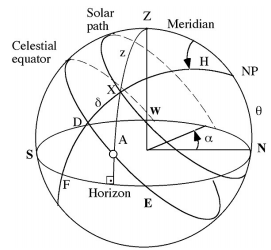This problem examines the seasonal solar radiation budget at three geographical locations: the Equator, 40º North, and 80º North.

NOTES: At a given geographical location, N, S, E, and W are the north, south, east and west points of the local horizon (also called "cardinal points" different from the same term applied to the precession of the equinoxes discussed in this course), O=observer on Earth, NP=celestial north pole, Z=zenith, X=location of sun at some instant, z=distance XZ to zenith, A=altitude of the sun (π/2-z), δ=declination of sun DX, which currently varies between ± 23.5º throughout the year, α=azimuth of sun; H=hour angle of sun measured from the meridian. During the day, the sun's rays strike the Earth's surface through a series of positive-valued angles A = 0o to a maximum Amax at meridian transit, and back to 0o. The vertical component, sinA is the "effective heating force." This is also expressed as zenith distance z = 90o-A. From spherical geometry: cosz = sinθsinδ + cosθcosδcosH. To calculate the total time that the sun is in the sky, set z = 90o (sunrise at the East horizon) to get: cosH = -tanθtanδ. Solve for H and divide by 15 o per hour (the Earth rotates 15 o per hour) to convert to time for the morning half of the day. Azimuth angles α of the rising and setting Sun are calculated from the formula: cosα = sinδ/cosθ.
For the summer and winter solstices, and spring (or fall) equinox of each location:
(A) Calculate the sunrise and sunset local horizon points (+α) in degrees from due North (note: west = negative, east=positive).
(B) Calculate the length of the day in hours, minutes, seconds.
(C) Using the solar constant So=1370 W/m2 , calculate the 'effective heating force' that reaches the top of the atmosphere per hour; plot these amounts on a graph of W/m2 vs. hour of the day. What is the summer/winter ratio of total daily insolation at each location? How does the total daily insolation at summer solstice compare among the three locations?